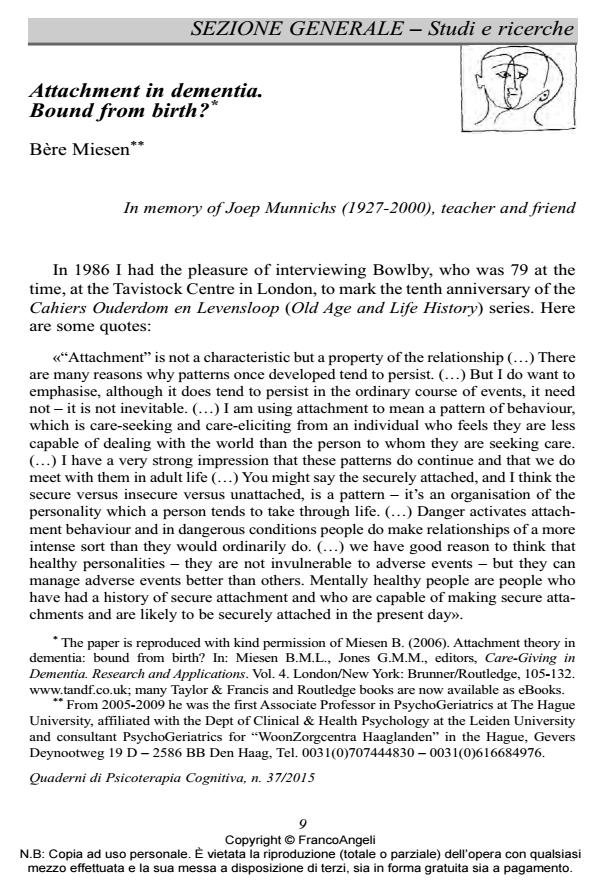Attachment in dementia. Bound from birth?
Titolo Rivista QUADERNI DI PSICOTERAPIA COGNITIVA
Autori/Curatori Bère Miesen
Anno di pubblicazione 2015 Fascicolo 2015/37
Lingua Inglese Numero pagine 36 P. 9-44 Dimensione file 208 KB
DOI 10.3280/QPC2015-037002
Il DOI è il codice a barre della proprietà intellettuale: per saperne di più
clicca qui
Qui sotto puoi vedere in anteprima la prima pagina di questo articolo.
Se questo articolo ti interessa, lo puoi acquistare (e scaricare in formato pdf) seguendo le facili indicazioni per acquistare il download credit. Acquista Download Credits per scaricare questo Articolo in formato PDF

FrancoAngeli è membro della Publishers International Linking Association, Inc (PILA)associazione indipendente e non profit per facilitare (attraverso i servizi tecnologici implementati da CrossRef.org) l’accesso degli studiosi ai contenuti digitali nelle pubblicazioni professionali e scientifiche
Dopo aver brevemente presentato la Teoria dell’Attaccamento, l’Autore illustra la ricchezza della sua applicazione in svariati ambiti clinici. I concetti di "comportamento di attaccamento" e di "storia dell’attaccamento" sembrano assumere, in questo contesto, un ampio valore esplicativo. La Teoria dell’Attaccamento di Bowlby è considerata, già da tempo, da molti ricercatori e clinici come un concetto fondante al quale fare riferimento per meglio comprendere la varietà dei comportamenti delle persone affette da demenza, dei loro familiari e dei professionisti della cura. L’ipotesi formulata suggerisce che le persone affette da demenza vivano in un mondo percepito come altamente traumatico, come conseguenza della loro crescente inabilità a riconoscere o attribuire un senso all’ambiente fisico ed al contesto sociale circostanti. Il concetto di "spazio di consapevolezza" é cruciale al fine di comprendere tale prospettiva del trauma. L’Autore evidenzia le modalità nelle quali la "strange situation", adattata al mondo degli anziani affetti da demenza, può fornire una chiave di lettura, in termini di attaccamento, circa i disturbi del comportamento, concepiti come l’espressione di bisogni di vicinanza e protezione.
Parole chiave:Demenza, attaccamento, strange situation, trauma, curanti
Bère Miesen, Attachment in dementia. Bound from birth? in "QUADERNI DI PSICOTERAPIA COGNITIVA" 37/2015, pp 9-44, DOI: 10.3280/QPC2015-037002